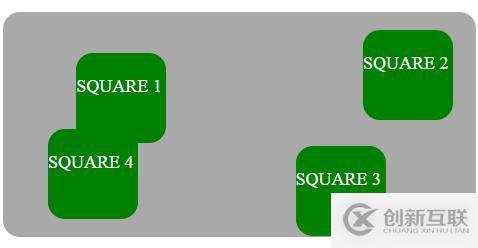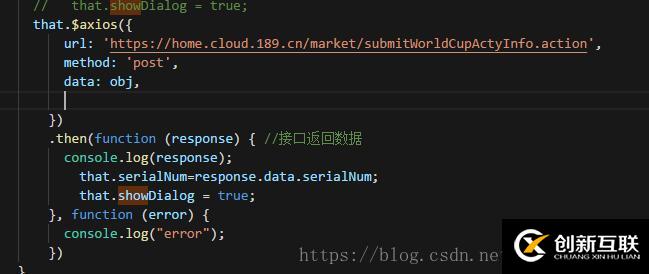使用css定位html元素的方法-創(chuàng)新互聯(lián)
使用css定位html元素的方法?這個(gè)問題可能是我們?nèi)粘W(xué)習(xí)或工作經(jīng)常見到的。希望通過這個(gè)問題能讓你收獲頗深。下面是小編給大家?guī)淼膮⒖純?nèi)容,讓我們一起來看看吧!

要在元素上使用定位,必須首先聲明其位置property,該位置指定用于元素的定位方法的類型。使用position屬性值,使用top,bottom,left和right屬性定位元素。它們的位置也取決于它們的位置值。(推薦課程:css視頻教程)
定位值有五種類型:static(靜態(tài)的)、relative(相對(duì)的)、fixed(固定的)、absolute(絕對(duì)的)、sticky(黏性的)
static(靜態(tài)的)
默認(rèn)情況下,HTML元素定位為靜態(tài),元素根據(jù)文檔的正常流程定位; 靜態(tài)定位元素不受頂部,底部,左側(cè)和右側(cè)屬性的影響。一個(gè)元素用position: static定位不會(huì)有其他特殊的定位方式。
用于將位置設(shè)置為靜態(tài)的CSS是:
position: static;
接下來是使用靜態(tài)位置值的示例:
<!DOCTYPE html>
<html>
<head>
<style>
body {
color: WHITE;
font: Helvetica;
width: 420px;
}
.square-set,
.square {
border-radius: 15px;
}
.square-set {
background: darkgrey;
}
.square {
position: static;
background: Green;
height: 70px;
line-height: 40px;
text-align: center;
width: 90px;
}
</style>
</head>
<body>
<div class="square-set">
<figure class="square square-1">SQUARE 1</figure>
<figure class="square square-2">SQUARE 2</figure>
<figure class="square square-3">SQUARE 3</figure>
<figure class="square square-4">SQUARE 4</figure>
</div>
</body>
</html>效果如下:

relative(相對(duì)的)
該元素根據(jù)文檔的正常流動(dòng)位于相對(duì)于它的正常位置被定位,然后偏移相對(duì)于本身的基于上,右,下和左的值。偏移量不會(huì)影響任何其他元素的位置; 因此,頁面布局中為元素給出的空間與位置是靜態(tài)的相同。設(shè)置相對(duì)定位元素的頂部,右側(cè),底部和左側(cè)屬性將使其遠(yuǎn)離其正常位置進(jìn)行調(diào)整。其他內(nèi)容不會(huì)被調(diào)整以適應(yīng)元素留下的任何空白。
用于將位置設(shè)置為相對(duì)的CSS是:
position: relative;
以下示例使用相對(duì)位置值:
<!DOCTYPE html>
<html>
<head>
<style>
body {
color: white;
font: Helvetica ;
width: 420px;
}
.square-set,
.square {
border-radius: 15px;
}
.square-set {
background: darkgrey;
}
.square {
background: green;
height: 70px;
line-height: 40px;
position: relative;
text-align: center;
width: 80px;
}
.square-1 {
top: 15px;
}
.square-2 {
left: 50px;
}
.square-3 {
bottom: -23px;
right: 30px;
}
</style>
</head>
<body>
<div class="square-set">
<figure class="square square-1">SQUARE 1</figure>
<figure class="square square-2">SQUARE 2</figure>
<figure class="square square-3">SQUARE 3</figure>
<figure class="square square-4">SQUARE 4</figure>
</div>
</body>
</html>效果如下:

absolute(絕對(duì)的)
該元素將從普通文檔流中刪除,并且在頁面布局中,不會(huì)為該元素創(chuàng)建空間。元素相對(duì)于最近定位的祖先定位,如果有的話; 否則,它相對(duì)于初始包含塊放置,其最終位置由頂部,右側(cè),底部和左側(cè)的值確定。
用于將位置設(shè)置為絕對(duì)的CSS是:
position: absolute;
具有position: absolute; 相對(duì)于最接近的祖先定位的元素。如果絕對(duì)定位元素沒有定位祖先,它將使用文檔正文,并與頁面滾動(dòng)一起移動(dòng)。“定位”元素是其static位置的元素
以下例子強(qiáng)調(diào)元素的絕對(duì)位置:
<!DOCTYPE html>
<html>
<head>
<style>
.square-set {
color: WHITE;
background: darkgrey;
height: 200px;
position: relative;
border-radius: 15px;
font: Helvetica ;
width: 420px;
}
.square {
background: green;
height: 80px;
position: absolute;
width: 80px;
border-radius: 15px;
line-height: 60px;
}
.square-1 {
top: 10%;
left: 6%;
}
.square-2 {
top: 5;
right: -20px;
}
.square-3 {
bottom: -15px;
right: 40px;
}
.square-4 {
bottom: 0;
}
</style>
</head>
<body>
<div class="square-set">
<figure class="square square-1">SQUARE 1</figure>
<figure class="square square-2">SQUARE 2</figure>
<figure class="square square-3">SQUARE 3</figure>
<figure class="square square-4">SQUARE 4</figure>
</div>
</body>
</html>效果如下:

fixed(固定的)
它從正常文檔流中刪除的元素,并且在頁面布局中,沒有為元素創(chuàng)建空間。元素相對(duì)于由視口建立的初始包含塊定位,其最終位置由值top,right,bottom和left確定。此值始終創(chuàng)建新的堆疊上下文。
用于將位置設(shè)置為固定的CSS如下所示:
position: fixed;
元素position: fixed; 相對(duì)于視口定位,這意味著即使頁面滾動(dòng),它也始終保持在同一位置。top,right,bottom和left屬性用于定位元素。
sticky(黏性的)
該元素對(duì)應(yīng)于文檔的正常流程定位,然后根據(jù)頂部,右側(cè),底部和左側(cè)的值相對(duì)于其最接近的上升塊級(jí)別(包括與表格相關(guān)的元素)偏移。偏移量不會(huì)影響任何其他元素的位置。
此值始終創(chuàng)建新的堆疊上下文。請(qǐng)注意,粘性元素“粘附”到其最近的祖先,即使該祖先不是最近的實(shí)際滾動(dòng)祖先,也具有“滾動(dòng)機(jī)制”。
用于將位置設(shè)置為粘性的CSS是:
position: sticky;
position: sticky; 根據(jù)用戶的滾動(dòng)位置定位元素,并根據(jù)滾動(dòng)位置在 位置relative 和fixed位置之間切換。
重疊元素
網(wǎng)頁上的重疊元素非常有用,可以突出顯示,推廣和關(guān)注我們網(wǎng)頁上的重要內(nèi)容。在您的網(wǎng)站上制作元素疊加是非常有用且非常有價(jià)值的功能設(shè)計(jì)實(shí)踐。當(dāng)元素被定位時(shí),它們可以與其他元素重疊,因此為了指定順序(應(yīng)該在其他元素的前面或后面放置哪個(gè)元素),我們應(yīng)該使用z-index屬性。堆棧順序較大的元素始終位于堆棧順序較低的元素前面。作為通知,z-index屬性僅適用于定位元素(position:absolute,position:relative或position:fixed)。
以下示例顯示了z-index屬性如何在不同的方塊上工作:
<!DOCTYPE html>
<html>
<head>
<style>
.square-set {
color: white;
background: purple;
height: 170px;
position: relative;
border-radius: 15px;
font: Helvetica;
width: 400px;
}
.square {
background: orange;
border: 4px solid goldenrod;
position: absolute;
border-radius: 15px;
height: 80px;
width: 80px;
}
.square-1 {
position: relative;
z-index: 1;
border: dashed;
height: 8em;
margin-bottom: 1em;
margin-top: 2em;
}
.square-2 {
position: absolute;
z-index: 2;
background: black;
width: 65%;
left: 60px;
top: 3em;
}
.square-3 {
position: absolute;
z-index: 3;
background: lightgreen;
width: 20%;
left: 65%;
top: -25px;
height: 7em;
opacity: 0.9;
}
</style>
</head>
<body>
<div class="square-set">
<figure class="square square-1">SQUARE 1</figure>
<figure class="square square-2">SQUARE 2</figure>
<figure class="square square-3">SQUARE 3</figure>
</div>
</body>
</html>效果如下:

在圖像上定位文本
下面的示例使用上述CSS定位值在圖像上覆蓋一些文本:
<!DOCTYPE html>
<html>
<head>
<style>
.module{
background:
linear-gradient{
rgba(0, 4, 5, 0.6),
rgba(2, 0, 3, 0.6)
),
url(http://www.holtz.org/Library/Images/Slideshows/Gallery/Landscapes/43098-DSC_64xx_landscape-keltern-1_wall.jpg);
background-size: cover;
width: 600px;
height: 400px;
margin: 10px 0 0 10px;
position: relative;
float: left;
}
.mid h4 {
font-family: Helvetica;
font-weight: 900;
color: white;
text-transform: uppercase;
margin: 0;
position: absolute;
top: 30%;
left: 50%;
font-size: 3rem;
transform: translate(-50%, -50%);
}
</style>
</head>
<body>
<div class="module mid">
<h4>Wild nature</h4>
</div>
</body>
</html>效果如下:

感謝各位的閱讀!看完上述內(nèi)容,你們對(duì)使用css定位html元素的方法大概了解了嗎?希望文章內(nèi)容對(duì)大家有所幫助。如果想了解更多相關(guān)文章內(nèi)容,歡迎關(guān)注創(chuàng)新互聯(lián)網(wǎng)站制作公司行業(yè)資訊頻道。
新聞標(biāo)題:使用css定位html元素的方法-創(chuàng)新互聯(lián)
轉(zhuǎn)載注明:http://chinadenli.net/article10/gccdo.html
成都網(wǎng)站建設(shè)公司_創(chuàng)新互聯(lián),為您提供關(guān)鍵詞優(yōu)化、定制網(wǎng)站、定制開發(fā)、網(wǎng)站排名、網(wǎng)站維護(hù)、網(wǎng)站收錄
聲明:本網(wǎng)站發(fā)布的內(nèi)容(圖片、視頻和文字)以用戶投稿、用戶轉(zhuǎn)載內(nèi)容為主,如果涉及侵權(quán)請(qǐng)盡快告知,我們將會(huì)在第一時(shí)間刪除。文章觀點(diǎn)不代表本網(wǎng)站立場(chǎng),如需處理請(qǐng)聯(lián)系客服。電話:028-86922220;郵箱:631063699@qq.com。內(nèi)容未經(jīng)允許不得轉(zhuǎn)載,或轉(zhuǎn)載時(shí)需注明來源: 創(chuàng)新互聯(lián)
猜你還喜歡下面的內(nèi)容
- 怎么在微信公眾平臺(tái)中獲取用戶的OpenID-創(chuàng)新互聯(lián)
- CSS中的@import怎么用-創(chuàng)新互聯(lián)
- c語言遞歸函數(shù)的使用方法-創(chuàng)新互聯(lián)
- ASP.NETMVC5微信公眾平臺(tái)整合開發(fā)實(shí)戰(zhàn)教程-創(chuàng)新互聯(lián)
- ThinkPHP模板引擎導(dǎo)入資源文件的方法-創(chuàng)新互聯(lián)
- layui實(shí)現(xiàn)select區(qū)域聯(lián)動(dòng)的方法-創(chuàng)新互聯(lián)
- Android中的md5加密怎么與phpmd5加密保持一致-創(chuàng)新互聯(lián)

- 外貿(mào)網(wǎng)站建設(shè)創(chuàng)新互聯(lián)合作Google SEO推廣? 2023-05-05
- 外貿(mào)推廣:讓海量關(guān)鍵詞覆蓋google的秘訣 2016-03-17
- 【google搜索解析】Google搜索解析使用技巧 2020-07-24
- 「關(guān)鍵字排名的規(guī)范」Google評(píng)定關(guān)鍵字排名的規(guī)范 2016-04-20
- 講述一下google和百度優(yōu)化之間的差異化 2016-01-23
- 分享幾個(gè)Google搜索優(yōu)化的基本技巧方法 2016-04-15
- Google Ads主要有哪些推廣形式? 2023-05-05
- 網(wǎng)站登陸Google的關(guān)鍵:網(wǎng)站外部鏈接 2016-08-08
- 做百度的排名和做google搜索引擎優(yōu)化的差別 2020-03-31
- 為什么Google討厭我的外貿(mào)網(wǎng)站? 2015-05-16
- 八種Google SEO外鏈的做法,讓你的外貿(mào)自建站“活躍”起來 2016-03-27
- google網(wǎng)站優(yōu)化中熊貓算法的研究 2013-06-18